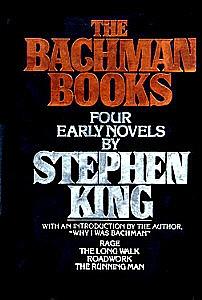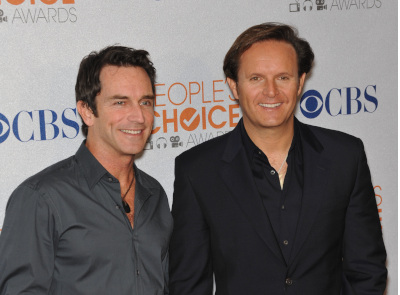Writers of fiction constantly create imaginary versions of the world. Sometimes they tweak the past or make changes to the present. It’s not terribly uncommon that they occasionally predict the future. Whether its Jules Verne figuring out Moon landing math in the 1800s or William Gibson coining the term “cyberspace” before a functional world wide web existed, some writers have divined what was yet to come with eerie accuracy. Forty years ago this month, one of the most famous writers in American history released an unassuming dystopian tale under his infamous pseudonym. The novel was The Running Man, and in it, Richard Bachman — or rather, Stephen King — proved that his talent went beyond scares to prognostication.

The Bachman identity developed from a couple of different directions. In the late 1970s, King’s publisher Signet was trying to hold the famously prolific author to one book a year. At the same time, King, having released huge bestsellers Carrie, Salem’s Lot, and The Shining in succession, was curious if his growing success was tied more to his name or the work. Those forces inspired King to invent a pseudonym under which he could publish books that weren’t the supernatural horror of his first three books, or his soon to-be published The Stand. King and Signet set up the Richard Bachman identity, and King released five books between 1977 and 1984 before bookstore clerk Steve Brown caught on. King happily allowed Brown to interview and expose him, and copies of his most recent Bachman book, Thinner, had their covers updated to read “Stephen King writing as Richard Bachman.”
The dystopian The Running Man, the fourth of the so-called Bachman books, was released in May of 1982. It shows King as a writer incredibly in tune with the future direction of America. Here’s what he got right.
1. An Entire Network for Game Shows

In The Running Man, the financially desperate Ben Richards seeks out a chance to compete on the titular game show. The series runs on the Games Network, a content provider that operates out of a skyscraper. When the book was released in 1982, the United States was still getting just the bare bones of modern basic cable. King probably figured that a network devoted to game shows was a total fantasy. However, cable exploded in the 1980s, with the number of channels booming. In 1994, Sony Pictures Television and the United Video Satellite Group launched Game Show Network, which reaches over 75 million American households today. Though none of the shows feature fights to the death, King was ahead of the curve on that type of channel by a good 12 years.
2. Reality Competitions

The rules of The Running Man have the competitor being chased across the country by Hunters in a televised life-or-death contest. The contestant gets prize money for killing Hunters and law-enforcement officers, and staying alive each day, while also sending recorded messages back to the network twice a day. A competitor who survives for 30 days earns $1 billion. Absent the murder portion, the rules of the game aren’t terribly dissimilar from dozens of shows across the reality competition genre. The most obvious successor in the U.S. would be Survivor, which launched in 2000 based on a format provided by the 1997 Swedish series Expedition Robinson. The traveling aspects of the competition are reflected in reality entries like Road Rules and The Amazing Race, while the recorded messages echo the “confessionals” pioneered in The Real World and imitated in dozens of shows since. King’s one-two punch of The Running Man and The Long Walk clearly inspired later fiction survival competition franchises like The Hunger Games by Suzanne Collins, The Maze Runner by James Dashner, Battle Royale by Koushun Takami, and the Squid Game television series by Hwang Dong-hyuk.
3. Pocket Cameras

Handheld communicators weren’t new ideas in science fiction. They’d been seen onscreen for years in films like Star Trek and Forbidden Planet. But the notion of pocket video cameras was much more novel, particularly in a 1982 where even videotape cameras were large and unwieldy. The first consumer camcorder was Sony’s Betamovie in 1983; it weighed around six pounds and used a Betamax cassette for its recording medium. Digital models wouldn’t be available until 1993. Of course, video recording is standard on today’s smart phones, which actually do fit in our pockets.
4. Poverty vs. Propaganda

King’s (or is it Bachman’s?) vision of the future in The Running Man has other uncomfortable parallels to today’s world. Big city poverty is rampant to the point where many groups are more or less permanent underclasses. One character theorizes that the news, and programs like The Running Man, are only there for the dual purposes of propaganda and making the populace forget about their own problems. Of course, critics from different political sides have always alleged that news operations are indulging in propaganda. On occasion, the allegations turn out to be true, like the March 2022 indictment of Jack Hanick for running afoul of U.S. sanctions and helping to launch an actual Russian propaganda network, Tsargrad TV.
5. Airplane as Weapon of Mass Destruction

One of the common refrains after the events of September 11, 2001, was that no one could imagine terrorists using American planes against American targets. That’s not entirely true. In fact, two of the most widely-read American writers had posited that scenario in books written years apart. In King’s The Running Man, Richards sacrifices himself by crashing a jet into the Games Network skyscraper. His strike at the system brings down the building and the network. Twelve years later, in Tom Clancy’s Debt of Honor, a terrorist crashes a 747 into the U.S. Capitol building during a joint session of Congress, killing the president, all of the Supreme Court Justices, several cabinet members and the majority of senators and representatives.
While most of King’s work tends toward horror and the supernatural, he’s always demonstrated adept handling of other genres, be they fantasy, prison dramas, or coming-of-age stories. On the occasions that he’s drifted into science fiction, he’s proven surprising prescient. Let’s hope his fiction doesn’t become reality when it comes to any number of vampire towns, possessed hotels, and particularly toothsome clowns.
Featured image: Shutterstock
Become a Saturday Evening Post member and enjoy unlimited access. Subscribe now



